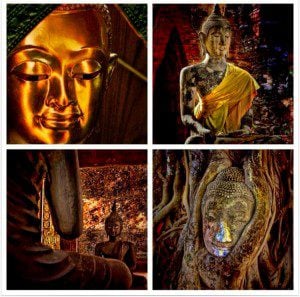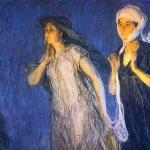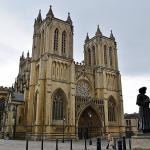 Note: This is the fifth of five post based on talks from Rohatsu 2014. Students (Brian, Ryan, Erik, and Vera-Ellen – thank you!) transcribed them and I edited. The final one will be posted here soon. Click here for the first part: “The Root of Zen.” Here for the second: “Sitting Through it All.” Here for the third: “Not Clear About the Self.” And here for the fourth: “Buddha’s Enlightenment: A Single Body is Revealed.”
Note: This is the fifth of five post based on talks from Rohatsu 2014. Students (Brian, Ryan, Erik, and Vera-Ellen – thank you!) transcribed them and I edited. The final one will be posted here soon. Click here for the first part: “The Root of Zen.” Here for the second: “Sitting Through it All.” Here for the third: “Not Clear About the Self.” And here for the fourth: “Buddha’s Enlightenment: A Single Body is Revealed.”
———
First, a word about “sesshin,” the word we use for intensive Zen retreats. “Sesshin” is composed of two characters. The second character “shin” is a very common character and means “heart,” “mind,” “essence,” or “spirit.”
The first character is quite important. It is composed of the radical for “hand” and then the character for “a woman standing over,” suggesting “to connect” or “to join.” One translation of “sesshin,” then, is “to join or connect with the heart.”
Playing a bit with the characters, we might portray “sesshin” as a woman standing, touching her heart. And so with “sesshin,” we have the two foci of receptivity and activity. The feminine, yielding principle, is standing up and touching the heart. The movement of the hand involved in touching the heart is the presentation of the essential activity of practice, turning the light around. Given that these characters grew up in a Confucian culture where it would be unusual for a woman to speak standing, there may be a suggestion here that “sesshin” is a bold act, an act that challenges the status quo.
In the last post, I ended with Fayan’s important expression of this principle, “In the myriad forms, a single body is revealed.” One of the virtues of sesshin, the yielding principle standing assertively and touching the heart, is how the simplicity of the Soto forms are illuminated. Indeed, the myriad forms – sitting, standing, walking, lying down – are our life as if it were composed by just four brushstrokes.
“In the myriad forms, a single body is revealed.” Sitting, standing, walking, lying down.
Instead of “body,” Fayan could have used other things as well. In the myriad forms, the single mind is revealed. In the myriad forms, the single the single heart is revealed. In the myriad forms, the single eye, the single liver, the single finger, the single fist, the single hand, or the single liver.
Here, though, the single body is revealed. We learn this practice in the body, from one person to another. And although there are many forms of practice, we studying the forms in the body. In my case, studying with Katagiri Roshi, was studying his body – how he walked, sat, ate. How he vacuumed the stairs, how he shoveled the sidewalk. I did that by yielding, being with him and touching the heart together.
A little while before he died, right after he was diagnosed with lymphoma, I asked him if he’d stick around awhile, ”Well, whatever happens,” he said, “I will always be there with you.”
The single body is revealed.
Our Zen lineage is intimately passed from person to person to person. We learn this too through koan introspection. In koan after koan, body meets body. How did those in this lineage embody this koan? A guy called Dosho bowed together with a guy named Myoun and we examined case after case in this way.
Transmission, then, comes from long study together.
We remember that when we embody the lineage in the morning service. Most of the Soto chanting service is an expression of the heart and is characterized by beautiful flowing together. When we chant the lineage, however, the chant leader holds the large bell with thumb and two fingers, striking the bell with the tip of the handle of the striker, creating a disharmonious, dead-hit sound. BAM! This is repeated as we begin the names of each of the seven Buddhas. It is a sound that pierces the ears, touches the heart, and jolts the body.
Just in this context, Keizan said, “While the seasons come and go, the mountains, rivers, and great earth change with time. You should know that this is Buddha raising his eyebrows and blinking his eyes. So it is in the myriad forms, the single body is revealed.”
The reference to “raising the eyebrows…” is to the story of the Buddha’s transmission to Mahakasyapa. One day when Shakyamuni came to the assembly to give a dharma talk, he just held up a flower, raised his eye brow, and blinked. Mahakasyapa smiled. This is regarded as the first transmission of the Dharma.
Keizan brings it into the body even more definitively, saying “the seasons coming and going, the mountains, rivers, and great earth changing with time” – this is the transmission of the Dharma. It’s that embodied; it’s that intimate.
Keizan was influenced by Shingon or the “True Word” school, which emphasizes mandala and creating the sacred space. For Keizan, the mandala, the sacred space, is not only the physical space of mountains, rivers, the great earth, and the whole great universe, but also the coming and going of time, as he indicates with “the passing of the seasons.”
Our practice and transmission takes place in that, as that universal mandala.
However, when we’re caught up in the maintenance of our dear little buddy “you,” the “artifact of unfulfilled ambition,” we forget that this whole planetary system is the transmission of the buddhadharma and that practice and life occur as the expression of this huge, incomprehensible space.
Also, when we’re engaged in “you” reification, it’s very hard to pay attention to the body of practice, of how to do it. When we’re absorbed in the “you,” we can either be hyper vigilant about it and miss the point or just absorbed in our own world rather than seeing what needs to be done and doing it.
How does body practice relate to our koan work? We put our body into the truth-happening-place narrative, put our body in the Buddha story. The unique power of the koan narrative is in finding a nonrepresentational way to present the truth.
Sometimes just-sitting Zen friends point out that our practice is not having any “sweet cookies.” Katagiri Roshi also said that quite often, “Zen practice is no sweet cookies.”
The implication seems to be that koan is somehow a sweet cookie, something to stop the baby from crying. Those of you who have taken up the mu koan might experience it differently. “Mu” means “no,” “non,” or “negation.” And to see the koan, we must be the koan, in this case, we must be one with “no,” “non,” or “negation.” That’s not much of a sweet cookie! Indeed, in becoming mu, it seems that the “you” might be erased.
When Xuishan, one of the monks who had accompanied Fayan when they first encountered Dizhang, returned from his pilgrimage and entered Dizhang’s room. Dizhang said, “Well, hi! Where have you been?”
Xuishan said, “I’ve been in the south.”
Dizhang said, “Oh, how’s the buddhadharma doing in the south these days?”
Xuishan said, “There’s much discussion.”
Dizhang said, “What does that have to do with me, planting my garden and harvesting rice?”
Our practice, day by day, is just taking care of business. The work of carrying beings from the shore of samsara to nirvana is an embodied activity. It requires, first of all, being willing to get your hands dirty.
Thank you for your practice.











